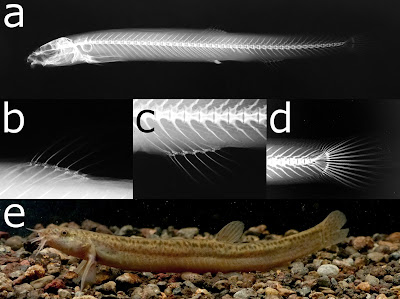 |
| Misgurnus amamianus Nakajima & Hashiguchi, 2022 |
Abstract
A new loach species, Misgurnus amamianus, is described based on 27 type specimens sampled from Ryukyu Islands, Japan. This new species can be distinguished from its congeners by the following combination of characteristics. 1) In adult males, a lamina circularis at the base of the pectoral fin is poleaxe-shaped and rounded at the back. 2) The last ray of dorsal fin is not branched, and its length is less than half the length of the second-branched soft ray. 3) The projected length from the posterior edge of the anal-fin base to the caudal-fin base is longer than the length from the insertion point of the pelvic fin to the anterior edge of the anal-fin base. 4) The ridges on the caudal peduncle at the upper and lower edges are weakly developed. The validity of this new species is also supported by the phylogenetic analysis of the mitochondrial DNA control region.
Key words: Cobitoidei, weather loach, freshwater fish, DNA barcoding
 |
| Misgurnus amamianus sp. nov. a, holotype (male, KPM-NI 68404); b, paratype (female, TKPM-P 26178). |
 |
| Misgurnus amamianus sp. nov., KPM-NI 68404, holotype. a, radiograph; b, radiograph of dorsal fin; c, radiograph of anal fin; d, radiograph of caudal fin; e, living body. |

Misgurnus amamianus sp. nov.
Diagnosis. The new species is distinguished from other species of Misgurnus by the combination of the follow-ing characteristics (Table 3): lamina circularis at base of pectoral fin in adult male poleaxe-shape (vs. spatula-shape in M. buphoensis and M. nikolskyi; elongated horizontally in M. dabryanus; absent in M. fossilis); neckline at base of lamina circularis shallow (vs. deep in M. anguillicaudatus); dorsal fin ray iii+6 (vs. commonly iii+7–8 in M. anguillicaudatus); last ray of dorsal fin commonly not branched (vs. commonly branched in M. anguillicaudatus, M. buohoensis, M. dabryanus, M. fossilis, M. mohoity and M. nikolskyi); L/S less than 0.5 (vs. over 0.5 in M. anguilicaudatus, M. buphoensis, M. dabryanus, M. mohoity and M. nikolskyi); LPC/DPA over 1.1 (vs. less than 1.0 in M. anguillicaudatus (China clade), M. dabryanus and M. tonkinensis); barbel length general (vs. long in M. dabryanus and M. tonkinensis); caudal-peduncle depth shallow (vs. deep in M. dabryanus, M. multimaculatus and M. tonkinensis); and total vertebrae number 44–48 (vs. over 49 in M. buphoensis, M. fossilis and M. nikolskyi).
Habitat and biology. Misgurnus amamianus inhabits the muddy bottoms of small streams, paddy fields, and ponds with rich vegetation. The life cycle is unknown, but it breeds from May to August in captivity. The loach has a strong tendency to hide in vegetation.
Etymology. The specific name was derived from the Amami Islands, which is the primary distribution area of this species. Japanese name is suggested as Shinobi-dojyô.
Jun Nakajima and Yasuyuki Hashiguchi. 2022. A New Species of the Genus Misgurnus (Cypriniformes, Cobitidae) from Ryukyu Islands, Japan. Zootaxa. 5162(5); 525-540. DOI: 10.11646/zootaxa.5162.5.4